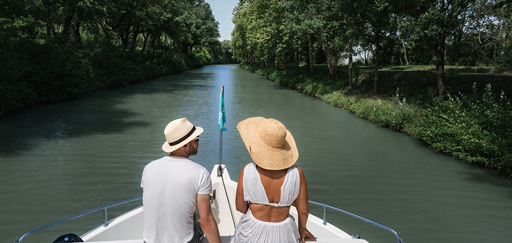You’ve chosen Italy for your boating holiday in a Pénichette® – good choice! You can look forward to la dolce vita and plenty of linguine alle vongole and tiramisù. But there are a few safety rules that you need to follow in Italy, where boating can be different from what happens in other countries.
Here are some good practice guidelines to keep in mind when you’re cruising on your self-drive boating holiday in Venice. But don’t worry: our staff will remind you of any special points that apply to this destination when you arrive in Chioggia.
1 – Depth of water
The water in the lagoon and the canals connects with the sea and the level is not controlled by locks. So it varies with the tides and can be as low as 100 cm. When you’re mooring, it’s important to bear this figure in mind and to take the following few precautions:
– Check the depth of the water where you intend to stop so that you don’t run aground at low tide;
– Leave mooring lines as slack as possible so that the boat can swing with the tide;
– Fix the fenders in such a way that they will protect the boat at both low and high tide.
2 – Boating in the lagoon
You can only sail within the lagoon by following the channels (canali), indicated by posts that could be single or in groups known as briccole. You have to identify the entrance to a channel – indicated by a group of posts, with one about 70 centimetres higher than the rest – and then cruise close to the other briccoles, which are spaced 5 to 20 metres apart, always keeping to the numbered side.
3 – Swells
Quite large swells can occur in the lagoon. If this happens, the best thing to do is berth somewhere safe and sheltered. In Venice, you are only allowed to moor in harbour basins (the ones at San Giorgio and Sant’Elena are the most welcoming).
Please note, it is strictly forbidden to take your boat into the Grand Canal in Venice and Murano.
4 – Wind and steering direction
Our boats are fitted with engines with a maximum power of 40 HP, providing a cruising speed of around 7 knots. When there is a strong wind or current, it is better to stay at your mooring. If necessary, remember that it’s better to steer against the wind and the current.
5 – Arrival and departure manoeuvres
Manoeuvring with the current, especially in narrow canals and passages, is mainly done by hand. Bring the bow slowly towards the bank, find a good place for a crew member to secure a mooring line, and hold the boat still in this position, using the line. Allow the force of the current to swing the boat around completely until it is up against the bank. Moor the boat if you are intending to berth.
To move off against the current, after casting off the mooring lines, push the boat away from the bank, again with the help of a crew member, and engage the engine. To leave in the direction of the current but with the bow turned against the current, first cast off the forward mooring line and push the boat away from the bank, allowing the force of the current to swing the boat around, while allowing some slack on the stern mooring line. Wait until the boat is in the perfect position before casting off completely, and engage the throttle.
6 – Waiting manoeuvres
In locks, it is a good idea to cut the engine. By doing this you’ll avoid blocking the engine’s cooling system filters with mud stirred up while passing through the lock.
Pass under mobile bridges with the current and stay well away from the bridge (at least 50 metres) to avoid ending up crosswise under the bridge. Wait until the bridge is completely open before engaging the throttle and passing through quickly.
7 – In very shallow water or aground
If you inadvertently or in any other circumstances end up stranded in very shallow water or aground, you must:
– Put the engine into neutral.
– Check that the cooling water is coming out of the exhaust normally. If not, cut the engine and carry out the necessary checks. Prime the pump before restarting the engine.
– Transfer as much weight as possible to the bow and turn the boat manually by about 180 degrees, accelerating slowly and gradually.
The other solution is to anchor and wait for high tide.
If you ask to be towed off by another vessel, make sure you fix the line to the bow: the boat must be able to turn through 180 degrees.
You now have all the information and boating advice you need to set off to Italy with no worries! Set a course for Venice and its lagoon for an idyllic boating holiday at an Italian pace!

















![Home_GB[1]](https://www.locaboat.com/wp-content/uploads/2025/02/Home_GB1.png)



